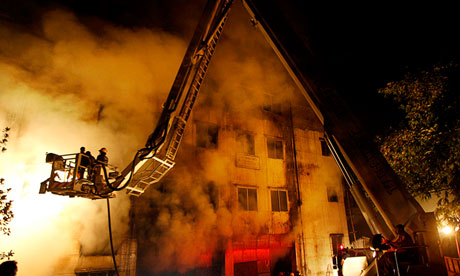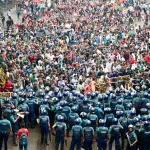Guardian Report?by Saad Hammadi
 Firefighters battle the blaze at the Tazreen Fashions plant in Dhaka, Bangladesh. Photograph: Hasan Raza/AP
Firefighters battle the blaze at the Tazreen Fashions plant in Dhaka, Bangladesh. Photograph: Hasan Raza/AP
Sunday 25 November 2012
Blaze occured at Tazreen Fashions in Dhaka, which makes clothes for foreign clients including high-street chain C&A
Survivors have described how a fire tore through a multi-storey garment factory just outside Bangladesh’s capital, Dhaka, killing more than 100 of their colleagues in one of the worst such incidents in recent years.
Mohammad Shahbul Alam, 26, described flames filling two of the three stairwells of the nine-floor building ? where clothes for international brands including high-street names appear to have been made ? shortly after the fire alarm had been raised.
Rooms full of female workers were cut off as piles of yarn and fabric filling corridors ignited. Reports also suggested fire exits at the site had locks on, which had to be broken in order for staff to escape.
Report by BBC
“It was 6.45 pm when the fire alarm was raised. I rushed out. I heard that [grills blocking the way to] the second and third floors were locked. When I came down, I saw fire at both the stairways that the ladies used. I still have not found any trace of my sister-in-law,” Alam told the Guardian.
According to Zakir Hossain, another worker, management told their employees not to evacuate immediately.
“The office staff asked us to stay where we were, telling us not to panic. We did not listen to them and started moving out,” Hossain recalled. “A lot of people were stuck there. Some people got out climbing down the bamboo [scaffolding] tied against the building.”
Witnesses said many workers leapt from upper stories in a bid to escape the flames. Twelve workers died in hospital from injuries sustained in falls, officials said, bringing the overall toll to 123 dead and more than 150 injured.
The blaze will focus attention once more on the conditions in which workers producing clothes for sale in the west work.
Fires in textiles and garments factories across south Asia have killed hundreds in recent months. More than 280 died in oneat a site in Karachi, Pakistan, in September.
Delwar Hossein, the managing director of the Dhaka factory, told the Guardian that the factory, Tazreen Fashions, had been making clothes for European high street giant C&A among other clients.
“I lived on these workers’ efforts,” he said. “I could not do anything for my workers. I do not know what went wrong and cannot understand why the staff could not get out of the building.”
There was no immediate response from C&A.
The factory, in the Ashulia industrial zone, is one of around 4,000 such installations in Bangladesh, many of which operate with minimal safeguards against fire or industrial accidents. The country annually earns about ?12.5bn from exports of garment products, mainly to the US and Europe.
Earlier this year, more than 300 factories near the capital were shut for almost a week as workers demanded higher wages and better working conditions.
Siddiq Ur Rahman, acting president of Bangladesh Garment Manufacturers and Exporters Association said the families of the dead would receive 100,000 aka (?760) as compensation.
Abu Nayeem Mohammad Shahidullah, director general of the Dhaka fire brigade, told reporters the toll could still rise.
Army soldiers and border guards had been deployed to help police keep order at the scene of the tragedy as thousands of anxious and angry relatives of the factory workers gathered.
Kalpona Akter, from the Bangladesh Centre for Workers’ Solidarity (BCWS), said: “We initially thought the fire broke out from generator but I checked the generator room today and it was not from there.”.
Akter said that locks on exits at the factory had been broken, indicating that the gates had been locked when the fire broke out. Most bodies are too badly burned for immediate investigation. Fire service officials have said they believe a short circuit was responsible.
Please Retweet #garments #bangladesh
Mohammad Shahbul Alam, 26, described flames filling two of the three stairwells of the nine-floor building ? where clothes for international brands including high-street names appear to have been made ? shortly after the fire alarm had been raised.
Rooms full of female workers were cut off as piles of yarn and fabric filling corridors ignited. Reports also suggested fire exits at the site had locks on, which had to be broken in order for staff to escape.
Report by BBC
“It was 6.45 pm when the fire alarm was raised. I rushed out. I heard that [grills blocking the way to] the second and third floors were locked. When I came down, I saw fire at both the stairways that the ladies used. I still have not found any trace of my sister-in-law,” Alam told the Guardian.
According to Zakir Hossain, another worker, management told their employees not to evacuate immediately.
“The office staff asked us to stay where we were, telling us not to panic. We did not listen to them and started moving out,” Hossain recalled. “A lot of people were stuck there. Some people got out climbing down the bamboo [scaffolding] tied against the building.”
Witnesses said many workers leapt from upper stories in a bid to escape the flames. Twelve workers died in hospital from injuries sustained in falls, officials said, bringing the overall toll to 123 dead and more than 150 injured.
The blaze will focus attention once more on the conditions in which workers producing clothes for sale in the west work.
Fires in textiles and garments factories across south Asia have killed hundreds in recent months. More than 280 died in oneat a site in Karachi, Pakistan, in September.
Delwar Hossein, the managing director of the Dhaka factory, told the Guardian that the factory, Tazreen Fashions, had been making clothes for European high street giant C&A among other clients.
“I lived on these workers’ efforts,” he said. “I could not do anything for my workers. I do not know what went wrong and cannot understand why the staff could not get out of the building.”
There was no immediate response from C&A.
The factory, in the Ashulia industrial zone, is one of around 4,000 such installations in Bangladesh, many of which operate with minimal safeguards against fire or industrial accidents. The country annually earns about ?12.5bn from exports of garment products, mainly to the US and Europe.
Earlier this year, more than 300 factories near the capital were shut for almost a week as workers demanded higher wages and better working conditions.
Siddiq Ur Rahman, acting president of Bangladesh Garment Manufacturers and Exporters Association said the families of the dead would receive 100,000 aka (?760) as compensation.
Abu Nayeem Mohammad Shahidullah, director general of the Dhaka fire brigade, told reporters the toll could still rise.
Army soldiers and border guards had been deployed to help police keep order at the scene of the tragedy as thousands of anxious and angry relatives of the factory workers gathered.
Kalpona Akter, from the Bangladesh Centre for Workers’ Solidarity (BCWS), said: “We initially thought the fire broke out from generator but I checked the generator room today and it was not from there.”.
Akter said that locks on exits at the factory had been broken, indicating that the gates had been locked when the fire broke out. Most bodies are too badly burned for immediate investigation. Fire service officials have said they believe a short circuit was responsible.
Please Retweet #garments #bangladesh





Leave a Reply
You must be logged in to post a comment.